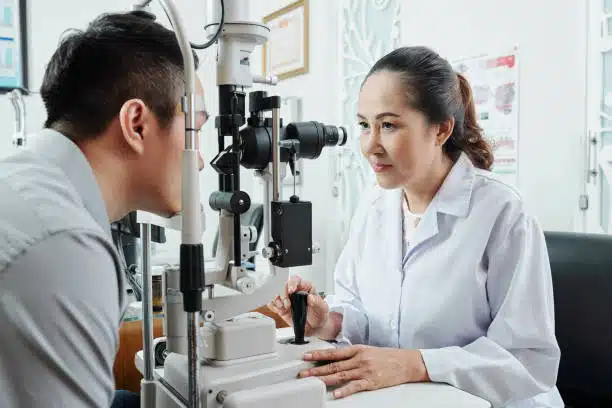Discover Advanced Solutions at Opticore Optometry for Eye Health
Discover Advanced Solutions at Opticore Optometry for Eye Health
Blog Article
Checking Out the current Technical Innovations in Optometry and What They Mean for Optometrists
From the accuracy of Optical Coherence Tomography to the nuanced insights offered by AI-driven analysis devices, these innovations are setting brand-new standards in client analysis and treatment. As these innovations permeate the practice, eye doctors are faced with the challenge of welcoming these tools to boost client outcomes.
Advancements in Diagnostic Devices
Progressing the field of optometry, advancements in analysis tools have actually revolutionized the method eye care experts evaluate and detect aesthetic problems and ocular conditions. The past decade has actually experienced substantial technical developments, allowing even more thorough and exact examinations. Optical Comprehensibility Tomography (OCT), as an example, offers high-resolution cross-sectional pictures of the retina, permitting the very early detection of diseases such as glaucoma and age-related macular degeneration. This non-invasive imaging technique has actually come to be indispensable in modern optometric method.
One more trick technology is the intro of innovative corneal topography systems, which map the surface area curvature of the cornea with accuracy. These devices are especially helpful for fitting call lenses and identifying corneal problems. Electronic retinal imaging has actually transformed conventional ophthalmoscopy, supplying detailed, panoramic views of the retina that help with complete visual exams.
The development of wavefront aberrometry has actually likewise been crucial, enabling the analysis of refractive mistakes with unequaled accuracy (Optometrist Chino). This modern technology aids in customizing restorative lenses and improving surgical end results for refractive surgical procedures. Collectively, these analysis developments encourage optometrists to provide superior client treatment, guaranteeing very early intervention and tailored treatment strategies, eventually improving visual health results
AI in Individual Monitoring
Structure on the structure of innovative analysis tools, the incorporation of fabricated knowledge (AI) in client management stands for a transformative leap for optometry. AI systems are significantly employed to enhance efficiency, accuracy, and customization in person treatment.
In addition, AI-driven systems facilitate structured client interactions and administrative processes. Automated organizing, online assessments, and customized follow-up plans not just enhance patient contentment yet additionally optimize time monitoring for professionals. These systems can triage individuals based on the necessity of their conditions, making sure that those in crucial demand obtain timely focus.
Moreover, AI enhances decision-making by giving eye doctors with evidence-based suggestions and therapy paths. By integrating information from digital health and wellness records, AI devices supply insights that educate scientific choices, decreasing the threat of errors and enhancing client outcomes. As AI proceeds to develop, its role in person management will likely increase, reshaping the landscape of optometric care.
Developments in Retinal Imaging
In the realm of optometry, retinal imaging has observed remarkable technological developments that are improving analysis abilities and client treatment. Innovations such as Optical Comprehensibility Tomography (OCT) and fundus photography have changed how eye doctors picture and evaluate the retina.
Improved imaging techniques like OCT angiography are additional refining analysis precision. Opticore Optometry. Such advancements help with the recognition of minute retinal adjustments that might represent condition progression.
In addition, improvements in fabricated knowledge are boosting retinal imaging by making it possible for automatic evaluation of huge datasets. These systems assist eye doctors in determining patterns a measure of pathology, therefore boosting diagnostic precision and efficiency. Jointly, these innovations are transforming retinal imaging into a keystone of contemporary eye treatment, enhancing outcomes and expanding restorative possibilities.
Teleoptometry's Expanding Function
Teleoptometry is progressively becoming a vital part of eye treatment, driven by developments in electronic communication and diagnostic tools. This is specifically beneficial in underserved and rural areas where accessibility to specialized eye treatment is typically restricted.
The integration of expert system (AI) more improves teleoptometry, allowing the evaluation of visual information and aiding in the detection of ocular problems such as glaucoma and diabetic retinopathy. AI-powered formulas can swiftly translate complex imaging information, giving eye doctors with useful understandings that strengthen clinical decision-making.
In addition, teleoptometry supports connection of care via seamless combination with digital health and wellness documents (EHRs), permitting eye doctors to preserve thorough client backgrounds. When consulting with various professionals., this ensures that patients obtain tailored and regular treatment also.
In spite of these advantages, challenges stay, consisting of making sure data protection and handling person assumptions. Teleoptometry represents a considerable stride in the direction of more available, effective, and patient-centered eye care. As modern technology progresses, its duty is poised to increase even more.

Future Patterns in Eye Care
A myriad of innovative trends is readied to improve the future of eye treatment, driven by technological advancements and the advancing requirements of patients. One considerable site fad is the combination of man-made knowledge (AI) in diagnostics, which assures to boost the accuracy and effectiveness of eye evaluations. AI algorithms can assess vast quantities of data from retinal images, possibly discovering problems like diabetic person retinopathy and glaucoma earlier than conventional methods.
In addition, customized medication is getting grip in optometry, with hereditary screening notifying customized therapy plans. This strategy intends to maximize client results by tailoring treatments to private hereditary profiles. Wearable innovation, such as clever contact lenses, is likewise on home the perspective, offering real-time surveillance of intraocular stress or sugar levels, therefore giving continual insights right into systemic and ocular wellness.
The fostering of increased reality (AR) and online fact (VR) in training and client education is another emerging trend. These technologies use immersive experiences that can improve understanding and abilities both for optometrists and patients. As these patterns advance, eye doctors have to remain abreast of technological innovations to give advanced care, ensuring better patient outcomes and contentment in the vibrant landscape of eye care.
Verdict

Jointly, these analysis developments encourage optometrists to provide superior patient treatment, making certain very early intervention and tailored treatment strategies, eventually boosting visual health and wellness end results.

As these technologies proceed to evolve, eye doctors need to adapt and include them into practice, ultimately optimizing operations effectiveness and boosting the requirement of eye care supplied to patients.
Report this page